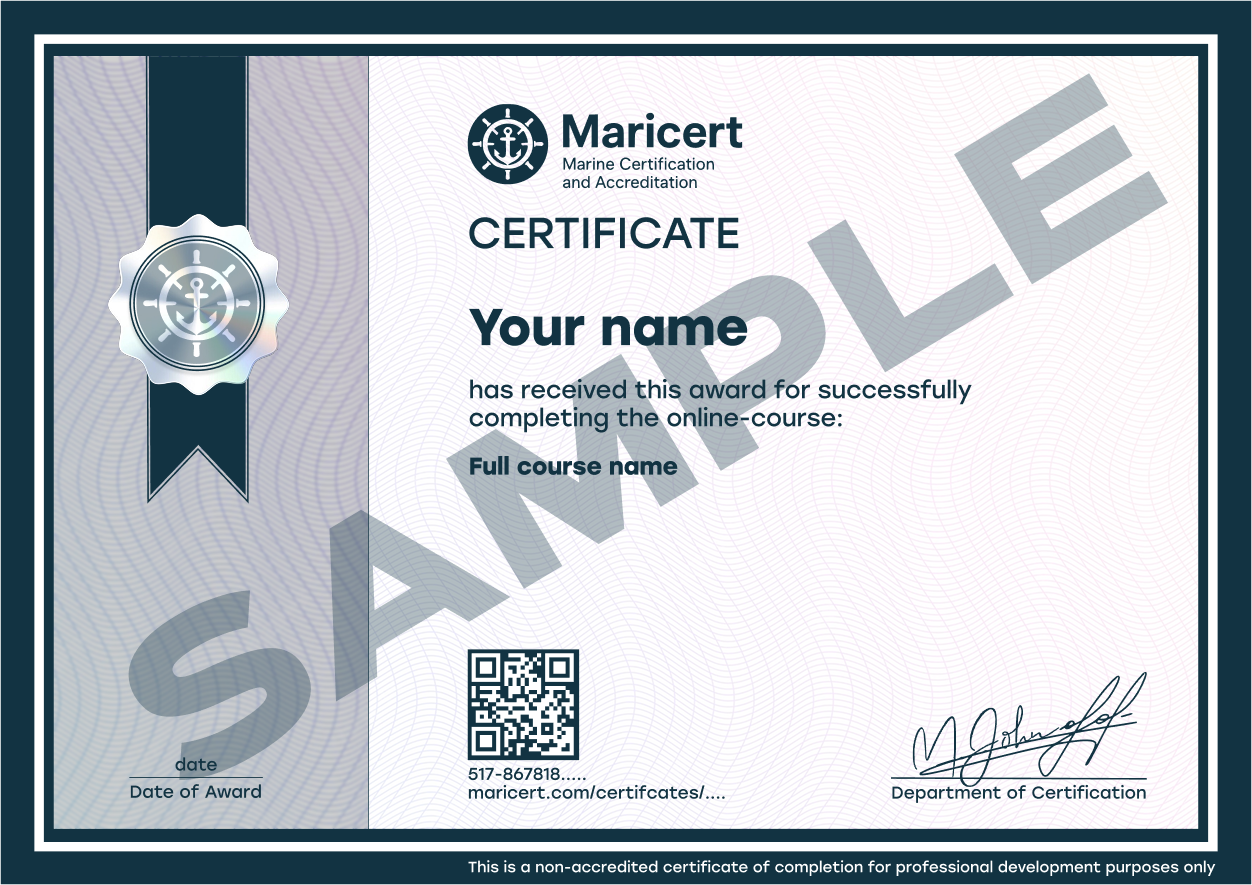Аdvanced seafood processing & safety: extending shelf life
LESSONS
- Glossary
- Introduction
- Seafood spoilage
- Seafood hazards
- Ensuring the best quality of raw seafood
- Seafood processing and preservation techniques
- Ensuring quality, safety, and authenticity of seafood
- Shellfish handling and primary processing
- Ensuring safe shellfish harvesting
- Shellfish classification systems in different countries
- Criteria for harvesting approvals and restrictions
- Prohibited shellfish harvesting areas and water quality standards
- Shellfish transportation and storage
- Shellfish processing methods
- Packing procedures for shellfish
- Ultraviolet light treatment for shellfish purification
- References
- Test
- Certificate


Duration
7–9 hours for studying the theoretical material, 2 hours for completing the final test.
Certificate
Upon successful completion of the online course, you will receive a certificate titled:
"Advanced Seafood Processing & Safety: Extending Shelf Life"
lifetime certificate.


Database registration
Each certificate has a unique serial number, is registered in our database, and includes a QR code for authenticity verification. Add your certificates when sending your CV, and your future employer will be able to verify them.
Course description
Unlock the science, technology, and safety behind modern seafood processing. With global seafood consumption steadily rising, maintaining quality and safety from ocean to plate has never been more critical. This in-depth course provides professionals with a comprehensive understanding of seafood processing methods, spoilage mechanisms, safety hazards, and innovative technologies driving the industry forward. You’ll explore the full seafood processing pipeline—from harvest to packaging—focusing on quality preservation, bacterial control, and consumer-ready product development. Learn how rigor mortis, microbial activity, enzymatic breakdown, and oxidation affect seafood freshness, and discover advanced preservation techniques like high-pressure processing, modified atmosphere packaging, minimal heat treatment, and super-chilling. The course also delves into the classification and safety control of shellfish harvesting areas, shellfish depuration systems, and regulatory standards across different countries. Through detailed case studies and scientific references, you’ll gain the knowledge and tools needed to evaluate seafood quality, implement sanitation protocols, ensure traceability, and minimize contamination risks.
What you’ll learn
- Principles of seafood spoilage and how to prevent it
- Seafood safety hazards: microbial, chemical, and viral
- Modern preservation techniques and technologies
- Best practices for harvesting, handling, and storage
- Shellfish safety, classification, and depuration methods
- Post-harvest treatments: HPP, irradiation, freezing, and pasteurization
- International regulatory standards and compliance
- Sustainable practices and waste reduction in seafood processing
- Quality assurance methods, from sensory testing to DNA barcoding
Who this course is for
- Seafood processors and quality managers
- Aquaculture and fishery professionals
- Food safety and regulatory officers
- Scientists and engineers in food technology
- Students and professionals seeking advanced industry knowledge
FAQ
First, please check your spam or promotions folder — sometimes emails land there. If you still don’t see anything, contact us at https://maricert.com/contact/ — we’ll check your order and grant access as soon as possible.
You can retake the test as many times as needed. There are no penalties or additional fees.
Yes. All lessons and tests are in written format. You can use Google Chrome with auto-translation or third-party tools. Our goal is to make learning accessible to everyone.
Absolutely. The platform is fully optimised for mobile. You can study from your phone, tablet, or laptop — whichever is most convenient for you.
You get 12 months of access from the date of purchase. You can study at your own pace. If the course isn’t completed within that period, access will be revoked without a refund. Refunds are not available once access is granted, as digital content is considered delivered in full (as per the UK Consumer Contracts Regulations 2013).
Your certificate will be sent to your email and also registered in the Certifier.io verification database. You'll receive a PDF version that you can attach to your CV.
Each certificate includes a unique ID and QR code. Employers can verify authenticity via the Certifier database or directly through the Maricert website.
Yes. We recommend including a direct Certifier.io link in your CV, cover letter, or LinkedIn profile to help build trust with employers.
No. Our courses are open to everyone, including beginners. You don’t need any maritime documents to enrol.
They can be added to your CV when applying for jobs on crabbing vessels, fishing fleets, seafood factories, and maritime logistics companies. They’re especially valuable for those with no prior experience.
Yes. While our certificates don’t guarantee a visa, they can serve as additional proof of qualifications when applying for seasonal or work visas.
We are not a recruitment agency, but our certificates and diplomas can improve your chances when applying directly to employers — especially if you’re new to the industry.
Yes. Maricert is officially registered in the UK Register of Learning Providers (UKPRN: 10098283) and complies with ICO (Information Commissioner's Office) data protection regulations.
Yes. You can purchase a course using another person’s email address or contact support to have access transferred after the purchase.
